Strategic Management Analysis of Microsoft Corporation Report SIM336
VerifiedAdded on 2023/01/11
|11
|3836
|40
Report
AI Summary
This report provides a comprehensive analysis of Microsoft Corporation's strategic management. It begins with an introduction to strategic management and its importance, followed by an overview of Microsoft's business, philosophy, and current market scenario. The main body of the report delves into Porter's Five Forces model, evaluating the bargaining power of suppliers and buyers, the threat of substitution and new entrants, and competitive rivalry within the industry. The report then applies Porter's generic strategies, including cost leadership, differentiation, and focus strategies, to assess Microsoft's strategic approach. Recommendations are provided to improve Microsoft's strategic positioning and competitive advantage. The report concludes with a summary of the findings and a list of references.
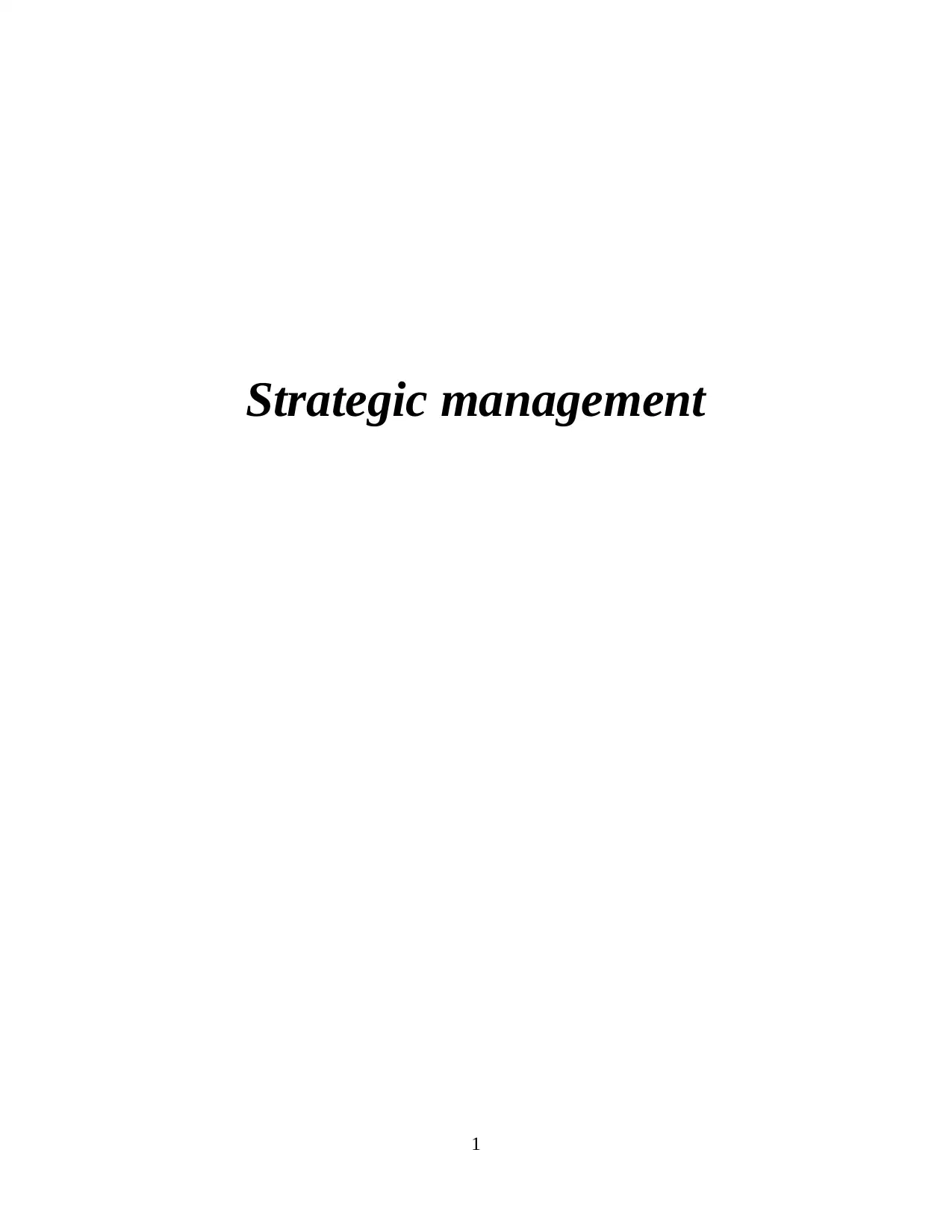
Strategic management
1
1
Paraphrase This Document
Need a fresh take? Get an instant paraphrase of this document with our AI Paraphraser
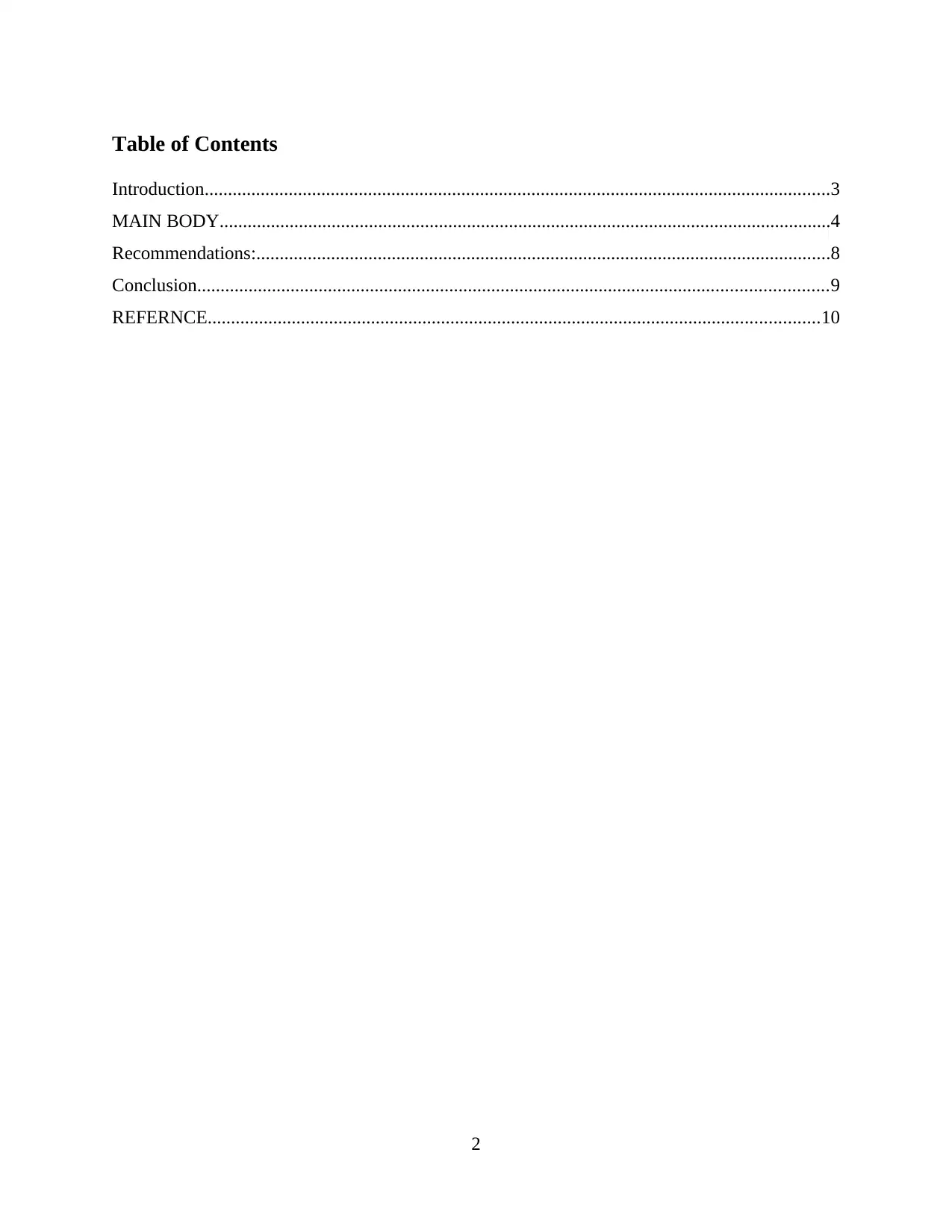
Table of Contents
Introduction......................................................................................................................................3
MAIN BODY...................................................................................................................................4
Recommendations:...........................................................................................................................8
Conclusion.......................................................................................................................................9
REFERNCE...................................................................................................................................10
2
Introduction......................................................................................................................................3
MAIN BODY...................................................................................................................................4
Recommendations:...........................................................................................................................8
Conclusion.......................................................................................................................................9
REFERNCE...................................................................................................................................10
2
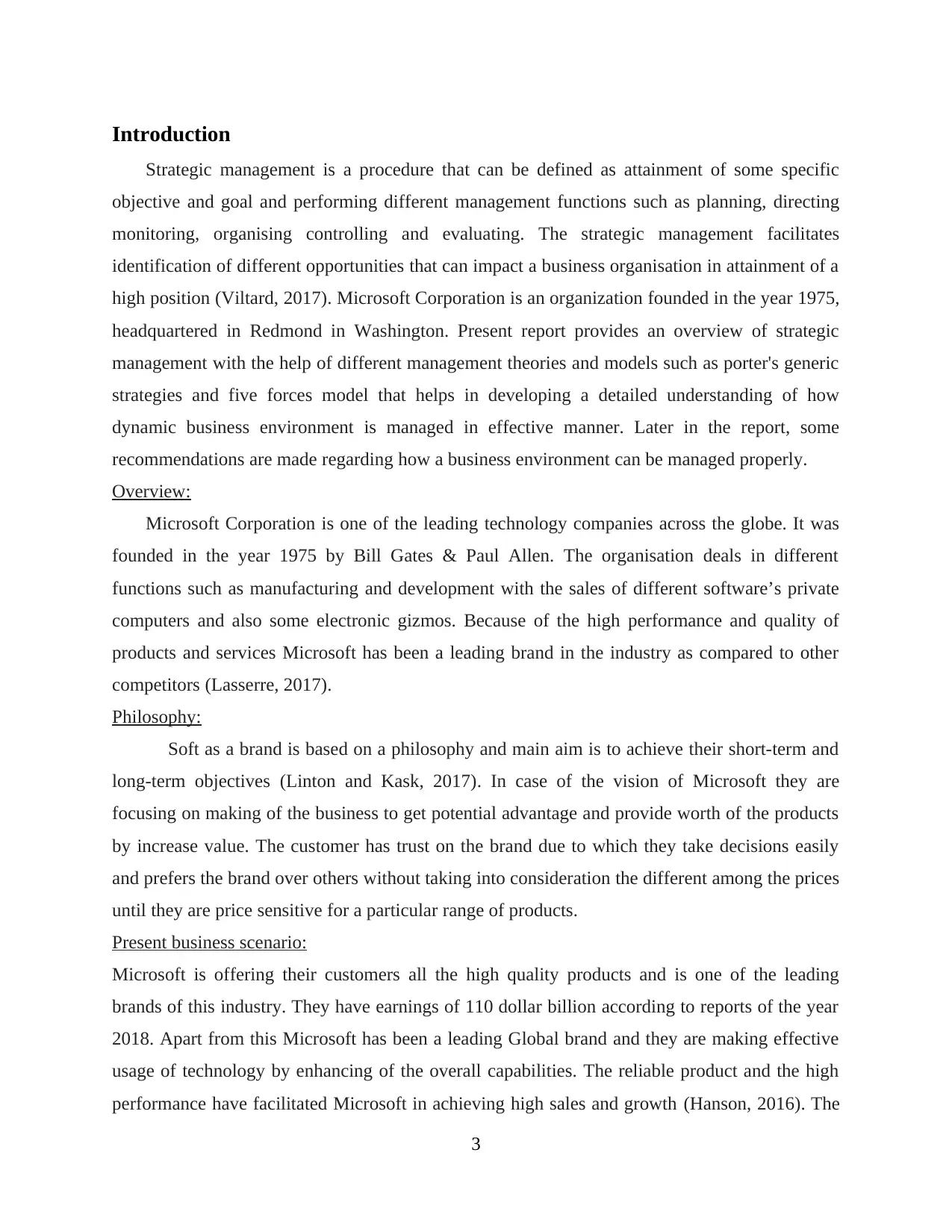
Introduction
Strategic management is a procedure that can be defined as attainment of some specific
objective and goal and performing different management functions such as planning, directing
monitoring, organising controlling and evaluating. The strategic management facilitates
identification of different opportunities that can impact a business organisation in attainment of a
high position (Viltard, 2017). Microsoft Corporation is an organization founded in the year 1975,
headquartered in Redmond in Washington. Present report provides an overview of strategic
management with the help of different management theories and models such as porter's generic
strategies and five forces model that helps in developing a detailed understanding of how
dynamic business environment is managed in effective manner. Later in the report, some
recommendations are made regarding how a business environment can be managed properly.
Overview:
Microsoft Corporation is one of the leading technology companies across the globe. It was
founded in the year 1975 by Bill Gates & Paul Allen. The organisation deals in different
functions such as manufacturing and development with the sales of different software’s private
computers and also some electronic gizmos. Because of the high performance and quality of
products and services Microsoft has been a leading brand in the industry as compared to other
competitors (Lasserre, 2017).
Philosophy:
Soft as a brand is based on a philosophy and main aim is to achieve their short-term and
long-term objectives (Linton and Kask, 2017). In case of the vision of Microsoft they are
focusing on making of the business to get potential advantage and provide worth of the products
by increase value. The customer has trust on the brand due to which they take decisions easily
and prefers the brand over others without taking into consideration the different among the prices
until they are price sensitive for a particular range of products.
Present business scenario:
Microsoft is offering their customers all the high quality products and is one of the leading
brands of this industry. They have earnings of 110 dollar billion according to reports of the year
2018. Apart from this Microsoft has been a leading Global brand and they are making effective
usage of technology by enhancing of the overall capabilities. The reliable product and the high
performance have facilitated Microsoft in achieving high sales and growth (Hanson, 2016). The
3
Strategic management is a procedure that can be defined as attainment of some specific
objective and goal and performing different management functions such as planning, directing
monitoring, organising controlling and evaluating. The strategic management facilitates
identification of different opportunities that can impact a business organisation in attainment of a
high position (Viltard, 2017). Microsoft Corporation is an organization founded in the year 1975,
headquartered in Redmond in Washington. Present report provides an overview of strategic
management with the help of different management theories and models such as porter's generic
strategies and five forces model that helps in developing a detailed understanding of how
dynamic business environment is managed in effective manner. Later in the report, some
recommendations are made regarding how a business environment can be managed properly.
Overview:
Microsoft Corporation is one of the leading technology companies across the globe. It was
founded in the year 1975 by Bill Gates & Paul Allen. The organisation deals in different
functions such as manufacturing and development with the sales of different software’s private
computers and also some electronic gizmos. Because of the high performance and quality of
products and services Microsoft has been a leading brand in the industry as compared to other
competitors (Lasserre, 2017).
Philosophy:
Soft as a brand is based on a philosophy and main aim is to achieve their short-term and
long-term objectives (Linton and Kask, 2017). In case of the vision of Microsoft they are
focusing on making of the business to get potential advantage and provide worth of the products
by increase value. The customer has trust on the brand due to which they take decisions easily
and prefers the brand over others without taking into consideration the different among the prices
until they are price sensitive for a particular range of products.
Present business scenario:
Microsoft is offering their customers all the high quality products and is one of the leading
brands of this industry. They have earnings of 110 dollar billion according to reports of the year
2018. Apart from this Microsoft has been a leading Global brand and they are making effective
usage of technology by enhancing of the overall capabilities. The reliable product and the high
performance have facilitated Microsoft in achieving high sales and growth (Hanson, 2016). The
3
⊘ This is a preview!⊘
Do you want full access?
Subscribe today to unlock all pages.

Trusted by 1+ million students worldwide
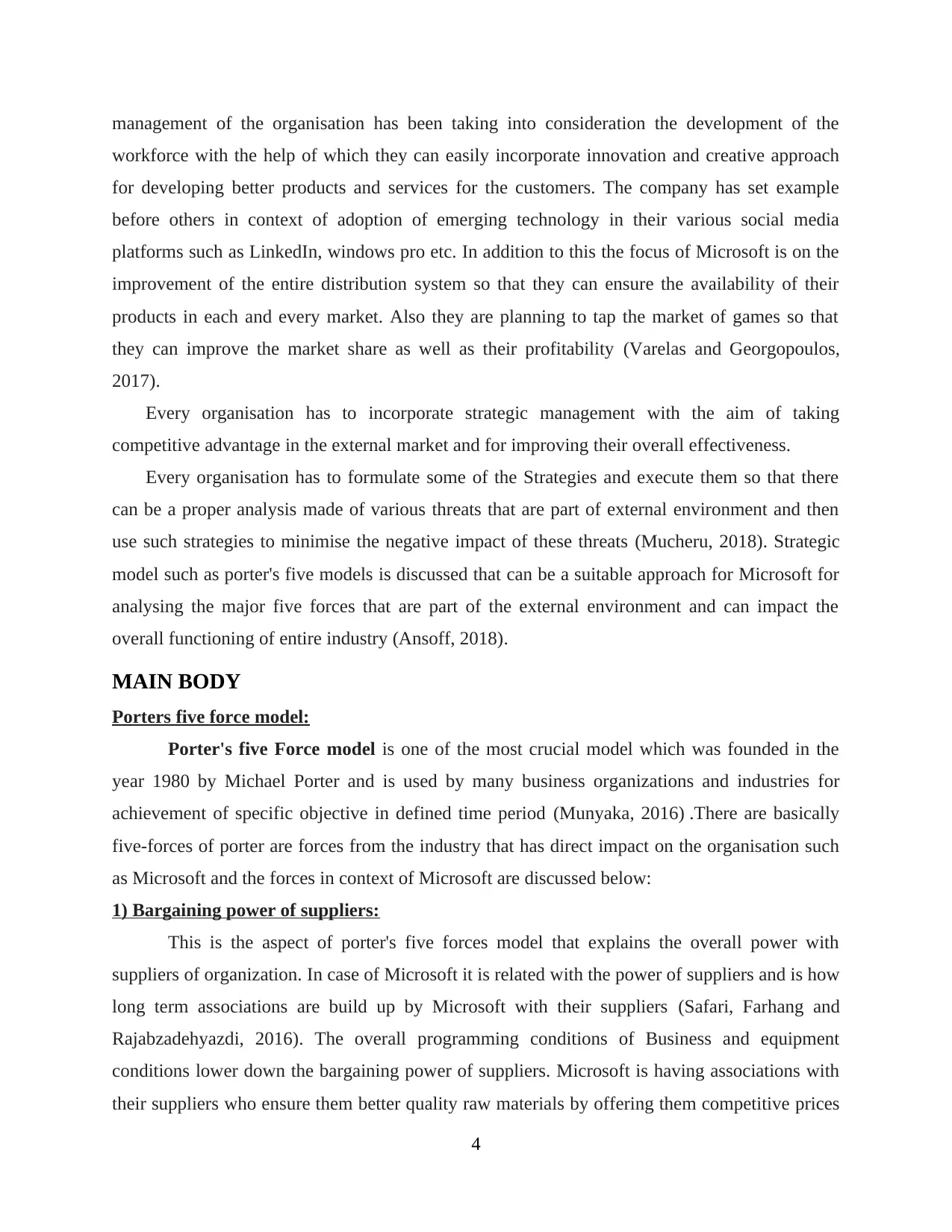
management of the organisation has been taking into consideration the development of the
workforce with the help of which they can easily incorporate innovation and creative approach
for developing better products and services for the customers. The company has set example
before others in context of adoption of emerging technology in their various social media
platforms such as LinkedIn, windows pro etc. In addition to this the focus of Microsoft is on the
improvement of the entire distribution system so that they can ensure the availability of their
products in each and every market. Also they are planning to tap the market of games so that
they can improve the market share as well as their profitability (Varelas and Georgopoulos,
2017).
Every organisation has to incorporate strategic management with the aim of taking
competitive advantage in the external market and for improving their overall effectiveness.
Every organisation has to formulate some of the Strategies and execute them so that there
can be a proper analysis made of various threats that are part of external environment and then
use such strategies to minimise the negative impact of these threats (Mucheru, 2018). Strategic
model such as porter's five models is discussed that can be a suitable approach for Microsoft for
analysing the major five forces that are part of the external environment and can impact the
overall functioning of entire industry (Ansoff, 2018).
MAIN BODY
Porters five force model:
Porter's five Force model is one of the most crucial model which was founded in the
year 1980 by Michael Porter and is used by many business organizations and industries for
achievement of specific objective in defined time period (Munyaka, 2016) .There are basically
five-forces of porter are forces from the industry that has direct impact on the organisation such
as Microsoft and the forces in context of Microsoft are discussed below:
1) Bargaining power of suppliers:
This is the aspect of porter's five forces model that explains the overall power with
suppliers of organization. In case of Microsoft it is related with the power of suppliers and is how
long term associations are build up by Microsoft with their suppliers (Safari, Farhang and
Rajabzadehyazdi, 2016). The overall programming conditions of Business and equipment
conditions lower down the bargaining power of suppliers. Microsoft is having associations with
their suppliers who ensure them better quality raw materials by offering them competitive prices
4
workforce with the help of which they can easily incorporate innovation and creative approach
for developing better products and services for the customers. The company has set example
before others in context of adoption of emerging technology in their various social media
platforms such as LinkedIn, windows pro etc. In addition to this the focus of Microsoft is on the
improvement of the entire distribution system so that they can ensure the availability of their
products in each and every market. Also they are planning to tap the market of games so that
they can improve the market share as well as their profitability (Varelas and Georgopoulos,
2017).
Every organisation has to incorporate strategic management with the aim of taking
competitive advantage in the external market and for improving their overall effectiveness.
Every organisation has to formulate some of the Strategies and execute them so that there
can be a proper analysis made of various threats that are part of external environment and then
use such strategies to minimise the negative impact of these threats (Mucheru, 2018). Strategic
model such as porter's five models is discussed that can be a suitable approach for Microsoft for
analysing the major five forces that are part of the external environment and can impact the
overall functioning of entire industry (Ansoff, 2018).
MAIN BODY
Porters five force model:
Porter's five Force model is one of the most crucial model which was founded in the
year 1980 by Michael Porter and is used by many business organizations and industries for
achievement of specific objective in defined time period (Munyaka, 2016) .There are basically
five-forces of porter are forces from the industry that has direct impact on the organisation such
as Microsoft and the forces in context of Microsoft are discussed below:
1) Bargaining power of suppliers:
This is the aspect of porter's five forces model that explains the overall power with
suppliers of organization. In case of Microsoft it is related with the power of suppliers and is how
long term associations are build up by Microsoft with their suppliers (Safari, Farhang and
Rajabzadehyazdi, 2016). The overall programming conditions of Business and equipment
conditions lower down the bargaining power of suppliers. Microsoft is having associations with
their suppliers who ensure them better quality raw materials by offering them competitive prices
4
Paraphrase This Document
Need a fresh take? Get an instant paraphrase of this document with our AI Paraphraser
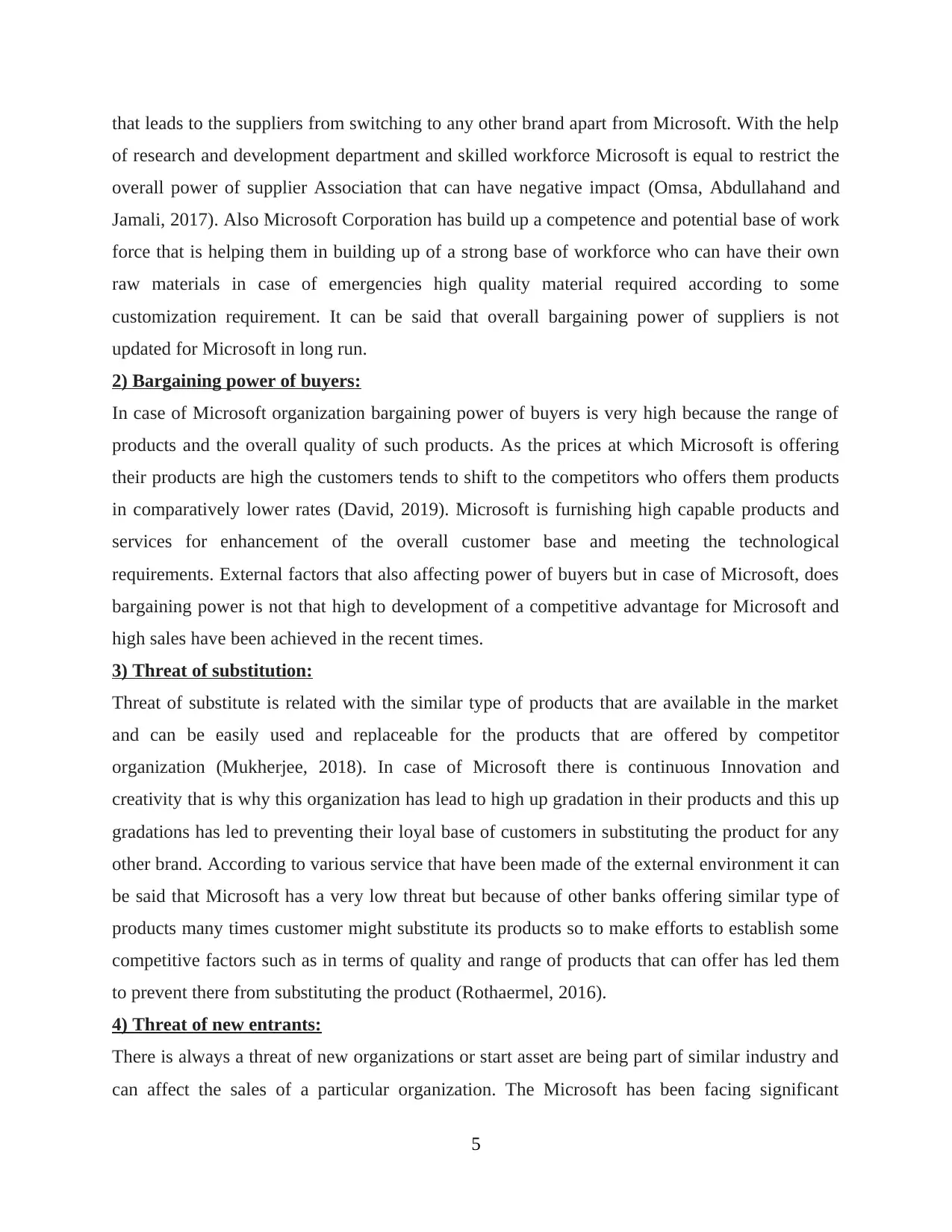
that leads to the suppliers from switching to any other brand apart from Microsoft. With the help
of research and development department and skilled workforce Microsoft is equal to restrict the
overall power of supplier Association that can have negative impact (Omsa, Abdullahand and
Jamali, 2017). Also Microsoft Corporation has build up a competence and potential base of work
force that is helping them in building up of a strong base of workforce who can have their own
raw materials in case of emergencies high quality material required according to some
customization requirement. It can be said that overall bargaining power of suppliers is not
updated for Microsoft in long run.
2) Bargaining power of buyers:
In case of Microsoft organization bargaining power of buyers is very high because the range of
products and the overall quality of such products. As the prices at which Microsoft is offering
their products are high the customers tends to shift to the competitors who offers them products
in comparatively lower rates (David, 2019). Microsoft is furnishing high capable products and
services for enhancement of the overall customer base and meeting the technological
requirements. External factors that also affecting power of buyers but in case of Microsoft, does
bargaining power is not that high to development of a competitive advantage for Microsoft and
high sales have been achieved in the recent times.
3) Threat of substitution:
Threat of substitute is related with the similar type of products that are available in the market
and can be easily used and replaceable for the products that are offered by competitor
organization (Mukherjee, 2018). In case of Microsoft there is continuous Innovation and
creativity that is why this organization has lead to high up gradation in their products and this up
gradations has led to preventing their loyal base of customers in substituting the product for any
other brand. According to various service that have been made of the external environment it can
be said that Microsoft has a very low threat but because of other banks offering similar type of
products many times customer might substitute its products so to make efforts to establish some
competitive factors such as in terms of quality and range of products that can offer has led them
to prevent there from substituting the product (Rothaermel, 2016).
4) Threat of new entrants:
There is always a threat of new organizations or start asset are being part of similar industry and
can affect the sales of a particular organization. The Microsoft has been facing significant
5
of research and development department and skilled workforce Microsoft is equal to restrict the
overall power of supplier Association that can have negative impact (Omsa, Abdullahand and
Jamali, 2017). Also Microsoft Corporation has build up a competence and potential base of work
force that is helping them in building up of a strong base of workforce who can have their own
raw materials in case of emergencies high quality material required according to some
customization requirement. It can be said that overall bargaining power of suppliers is not
updated for Microsoft in long run.
2) Bargaining power of buyers:
In case of Microsoft organization bargaining power of buyers is very high because the range of
products and the overall quality of such products. As the prices at which Microsoft is offering
their products are high the customers tends to shift to the competitors who offers them products
in comparatively lower rates (David, 2019). Microsoft is furnishing high capable products and
services for enhancement of the overall customer base and meeting the technological
requirements. External factors that also affecting power of buyers but in case of Microsoft, does
bargaining power is not that high to development of a competitive advantage for Microsoft and
high sales have been achieved in the recent times.
3) Threat of substitution:
Threat of substitute is related with the similar type of products that are available in the market
and can be easily used and replaceable for the products that are offered by competitor
organization (Mukherjee, 2018). In case of Microsoft there is continuous Innovation and
creativity that is why this organization has lead to high up gradation in their products and this up
gradations has led to preventing their loyal base of customers in substituting the product for any
other brand. According to various service that have been made of the external environment it can
be said that Microsoft has a very low threat but because of other banks offering similar type of
products many times customer might substitute its products so to make efforts to establish some
competitive factors such as in terms of quality and range of products that can offer has led them
to prevent there from substituting the product (Rothaermel, 2016).
4) Threat of new entrants:
There is always a threat of new organizations or start asset are being part of similar industry and
can affect the sales of a particular organization. The Microsoft has been facing significant
5
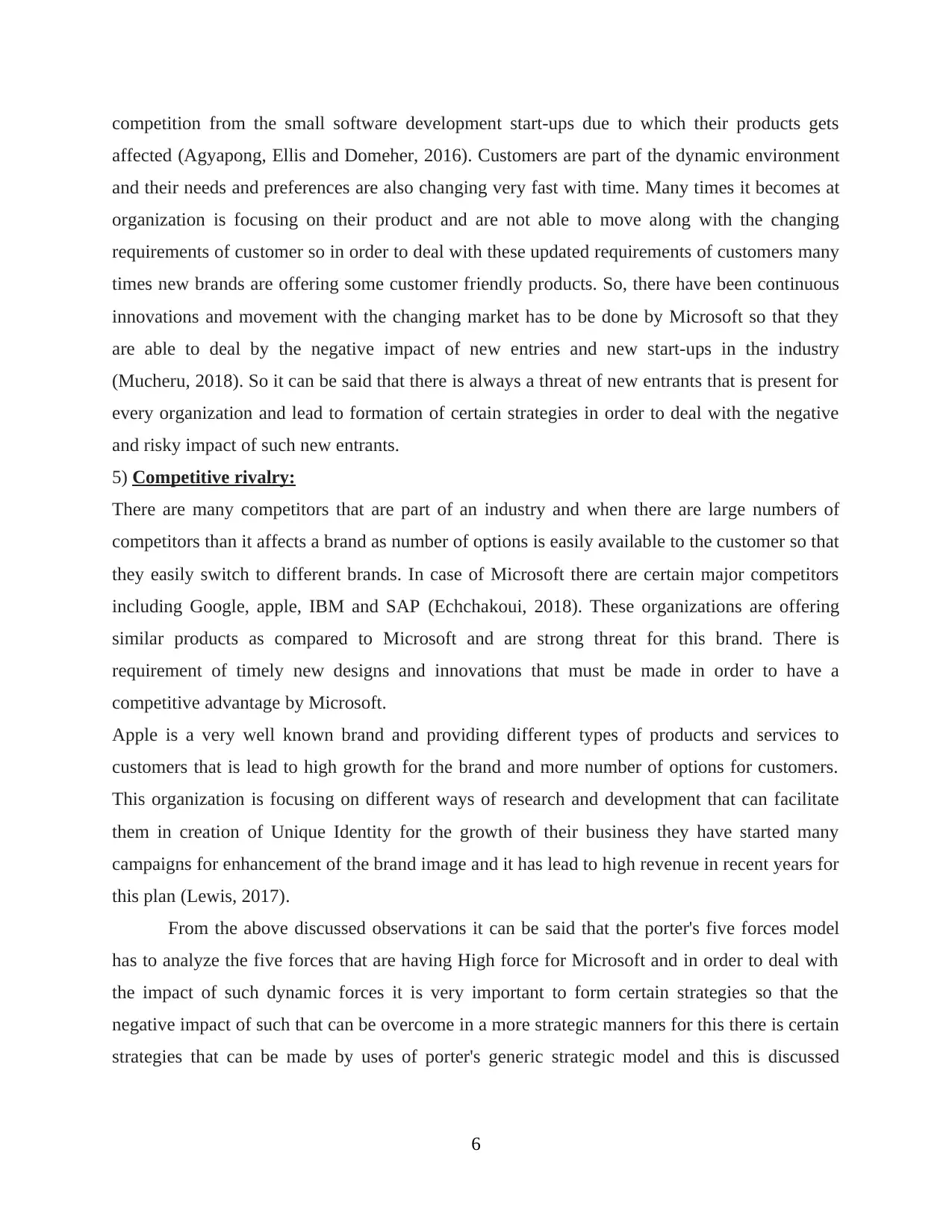
competition from the small software development start-ups due to which their products gets
affected (Agyapong, Ellis and Domeher, 2016). Customers are part of the dynamic environment
and their needs and preferences are also changing very fast with time. Many times it becomes at
organization is focusing on their product and are not able to move along with the changing
requirements of customer so in order to deal with these updated requirements of customers many
times new brands are offering some customer friendly products. So, there have been continuous
innovations and movement with the changing market has to be done by Microsoft so that they
are able to deal by the negative impact of new entries and new start-ups in the industry
(Mucheru, 2018). So it can be said that there is always a threat of new entrants that is present for
every organization and lead to formation of certain strategies in order to deal with the negative
and risky impact of such new entrants.
5) Competitive rivalry:
There are many competitors that are part of an industry and when there are large numbers of
competitors than it affects a brand as number of options is easily available to the customer so that
they easily switch to different brands. In case of Microsoft there are certain major competitors
including Google, apple, IBM and SAP (Echchakoui, 2018). These organizations are offering
similar products as compared to Microsoft and are strong threat for this brand. There is
requirement of timely new designs and innovations that must be made in order to have a
competitive advantage by Microsoft.
Apple is a very well known brand and providing different types of products and services to
customers that is lead to high growth for the brand and more number of options for customers.
This organization is focusing on different ways of research and development that can facilitate
them in creation of Unique Identity for the growth of their business they have started many
campaigns for enhancement of the brand image and it has lead to high revenue in recent years for
this plan (Lewis, 2017).
From the above discussed observations it can be said that the porter's five forces model
has to analyze the five forces that are having High force for Microsoft and in order to deal with
the impact of such dynamic forces it is very important to form certain strategies so that the
negative impact of such that can be overcome in a more strategic manners for this there is certain
strategies that can be made by uses of porter's generic strategic model and this is discussed
6
affected (Agyapong, Ellis and Domeher, 2016). Customers are part of the dynamic environment
and their needs and preferences are also changing very fast with time. Many times it becomes at
organization is focusing on their product and are not able to move along with the changing
requirements of customer so in order to deal with these updated requirements of customers many
times new brands are offering some customer friendly products. So, there have been continuous
innovations and movement with the changing market has to be done by Microsoft so that they
are able to deal by the negative impact of new entries and new start-ups in the industry
(Mucheru, 2018). So it can be said that there is always a threat of new entrants that is present for
every organization and lead to formation of certain strategies in order to deal with the negative
and risky impact of such new entrants.
5) Competitive rivalry:
There are many competitors that are part of an industry and when there are large numbers of
competitors than it affects a brand as number of options is easily available to the customer so that
they easily switch to different brands. In case of Microsoft there are certain major competitors
including Google, apple, IBM and SAP (Echchakoui, 2018). These organizations are offering
similar products as compared to Microsoft and are strong threat for this brand. There is
requirement of timely new designs and innovations that must be made in order to have a
competitive advantage by Microsoft.
Apple is a very well known brand and providing different types of products and services to
customers that is lead to high growth for the brand and more number of options for customers.
This organization is focusing on different ways of research and development that can facilitate
them in creation of Unique Identity for the growth of their business they have started many
campaigns for enhancement of the brand image and it has lead to high revenue in recent years for
this plan (Lewis, 2017).
From the above discussed observations it can be said that the porter's five forces model
has to analyze the five forces that are having High force for Microsoft and in order to deal with
the impact of such dynamic forces it is very important to form certain strategies so that the
negative impact of such that can be overcome in a more strategic manners for this there is certain
strategies that can be made by uses of porter's generic strategic model and this is discussed
6
⊘ This is a preview!⊘
Do you want full access?
Subscribe today to unlock all pages.

Trusted by 1+ million students worldwide
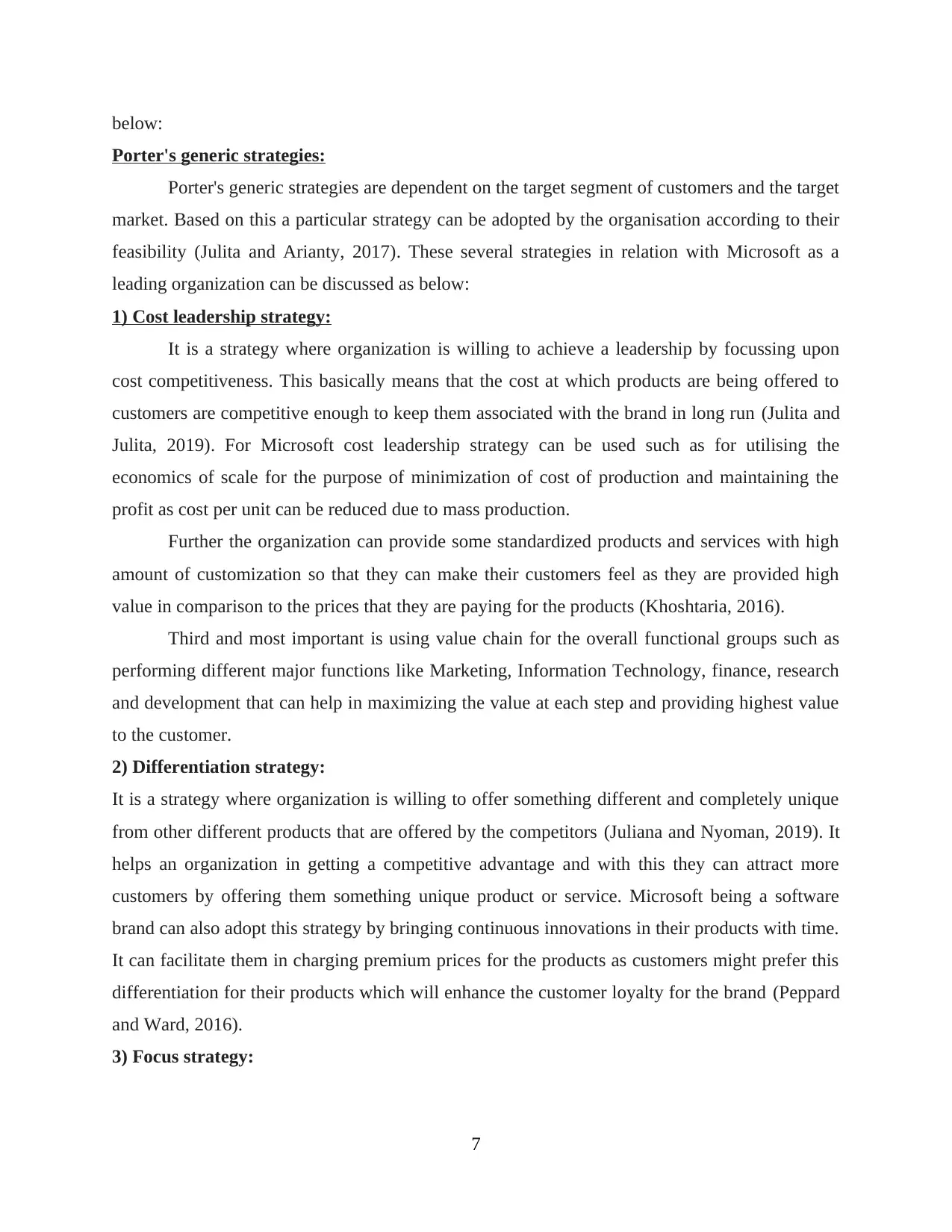
below:
Porter's generic strategies:
Porter's generic strategies are dependent on the target segment of customers and the target
market. Based on this a particular strategy can be adopted by the organisation according to their
feasibility (Julita and Arianty, 2017). These several strategies in relation with Microsoft as a
leading organization can be discussed as below:
1) Cost leadership strategy:
It is a strategy where organization is willing to achieve a leadership by focussing upon
cost competitiveness. This basically means that the cost at which products are being offered to
customers are competitive enough to keep them associated with the brand in long run (Julita and
Julita, 2019). For Microsoft cost leadership strategy can be used such as for utilising the
economics of scale for the purpose of minimization of cost of production and maintaining the
profit as cost per unit can be reduced due to mass production.
Further the organization can provide some standardized products and services with high
amount of customization so that they can make their customers feel as they are provided high
value in comparison to the prices that they are paying for the products (Khoshtaria, 2016).
Third and most important is using value chain for the overall functional groups such as
performing different major functions like Marketing, Information Technology, finance, research
and development that can help in maximizing the value at each step and providing highest value
to the customer.
2) Differentiation strategy:
It is a strategy where organization is willing to offer something different and completely unique
from other different products that are offered by the competitors (Juliana and Nyoman, 2019). It
helps an organization in getting a competitive advantage and with this they can attract more
customers by offering them something unique product or service. Microsoft being a software
brand can also adopt this strategy by bringing continuous innovations in their products with time.
It can facilitate them in charging premium prices for the products as customers might prefer this
differentiation for their products which will enhance the customer loyalty for the brand (Peppard
and Ward, 2016).
3) Focus strategy:
7
Porter's generic strategies:
Porter's generic strategies are dependent on the target segment of customers and the target
market. Based on this a particular strategy can be adopted by the organisation according to their
feasibility (Julita and Arianty, 2017). These several strategies in relation with Microsoft as a
leading organization can be discussed as below:
1) Cost leadership strategy:
It is a strategy where organization is willing to achieve a leadership by focussing upon
cost competitiveness. This basically means that the cost at which products are being offered to
customers are competitive enough to keep them associated with the brand in long run (Julita and
Julita, 2019). For Microsoft cost leadership strategy can be used such as for utilising the
economics of scale for the purpose of minimization of cost of production and maintaining the
profit as cost per unit can be reduced due to mass production.
Further the organization can provide some standardized products and services with high
amount of customization so that they can make their customers feel as they are provided high
value in comparison to the prices that they are paying for the products (Khoshtaria, 2016).
Third and most important is using value chain for the overall functional groups such as
performing different major functions like Marketing, Information Technology, finance, research
and development that can help in maximizing the value at each step and providing highest value
to the customer.
2) Differentiation strategy:
It is a strategy where organization is willing to offer something different and completely unique
from other different products that are offered by the competitors (Juliana and Nyoman, 2019). It
helps an organization in getting a competitive advantage and with this they can attract more
customers by offering them something unique product or service. Microsoft being a software
brand can also adopt this strategy by bringing continuous innovations in their products with time.
It can facilitate them in charging premium prices for the products as customers might prefer this
differentiation for their products which will enhance the customer loyalty for the brand (Peppard
and Ward, 2016).
3) Focus strategy:
7
Paraphrase This Document
Need a fresh take? Get an instant paraphrase of this document with our AI Paraphraser
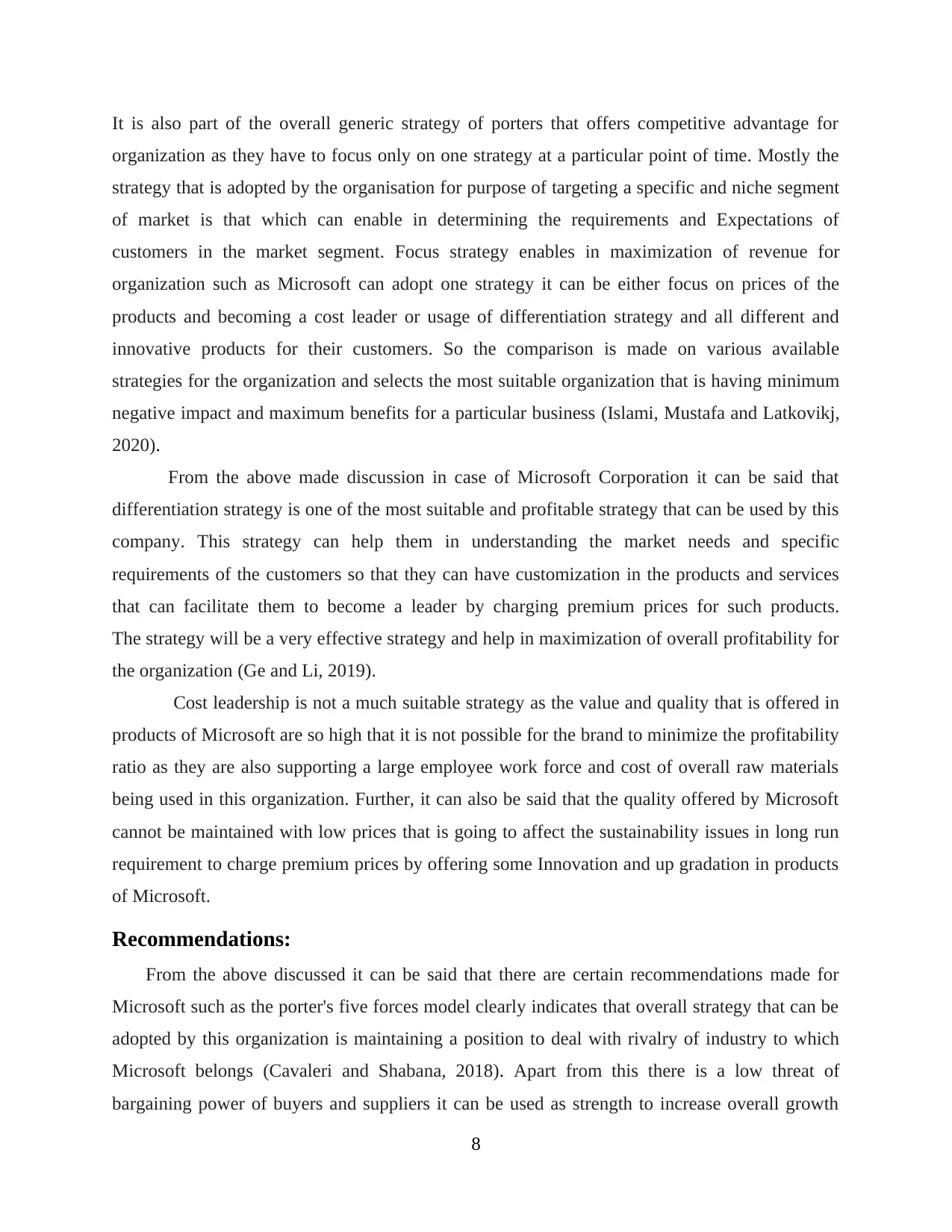
It is also part of the overall generic strategy of porters that offers competitive advantage for
organization as they have to focus only on one strategy at a particular point of time. Mostly the
strategy that is adopted by the organisation for purpose of targeting a specific and niche segment
of market is that which can enable in determining the requirements and Expectations of
customers in the market segment. Focus strategy enables in maximization of revenue for
organization such as Microsoft can adopt one strategy it can be either focus on prices of the
products and becoming a cost leader or usage of differentiation strategy and all different and
innovative products for their customers. So the comparison is made on various available
strategies for the organization and selects the most suitable organization that is having minimum
negative impact and maximum benefits for a particular business (Islami, Mustafa and Latkovikj,
2020).
From the above made discussion in case of Microsoft Corporation it can be said that
differentiation strategy is one of the most suitable and profitable strategy that can be used by this
company. This strategy can help them in understanding the market needs and specific
requirements of the customers so that they can have customization in the products and services
that can facilitate them to become a leader by charging premium prices for such products.
The strategy will be a very effective strategy and help in maximization of overall profitability for
the organization (Ge and Li, 2019).
Cost leadership is not a much suitable strategy as the value and quality that is offered in
products of Microsoft are so high that it is not possible for the brand to minimize the profitability
ratio as they are also supporting a large employee work force and cost of overall raw materials
being used in this organization. Further, it can also be said that the quality offered by Microsoft
cannot be maintained with low prices that is going to affect the sustainability issues in long run
requirement to charge premium prices by offering some Innovation and up gradation in products
of Microsoft.
Recommendations:
From the above discussed it can be said that there are certain recommendations made for
Microsoft such as the porter's five forces model clearly indicates that overall strategy that can be
adopted by this organization is maintaining a position to deal with rivalry of industry to which
Microsoft belongs (Cavaleri and Shabana, 2018). Apart from this there is a low threat of
bargaining power of buyers and suppliers it can be used as strength to increase overall growth
8
organization as they have to focus only on one strategy at a particular point of time. Mostly the
strategy that is adopted by the organisation for purpose of targeting a specific and niche segment
of market is that which can enable in determining the requirements and Expectations of
customers in the market segment. Focus strategy enables in maximization of revenue for
organization such as Microsoft can adopt one strategy it can be either focus on prices of the
products and becoming a cost leader or usage of differentiation strategy and all different and
innovative products for their customers. So the comparison is made on various available
strategies for the organization and selects the most suitable organization that is having minimum
negative impact and maximum benefits for a particular business (Islami, Mustafa and Latkovikj,
2020).
From the above made discussion in case of Microsoft Corporation it can be said that
differentiation strategy is one of the most suitable and profitable strategy that can be used by this
company. This strategy can help them in understanding the market needs and specific
requirements of the customers so that they can have customization in the products and services
that can facilitate them to become a leader by charging premium prices for such products.
The strategy will be a very effective strategy and help in maximization of overall profitability for
the organization (Ge and Li, 2019).
Cost leadership is not a much suitable strategy as the value and quality that is offered in
products of Microsoft are so high that it is not possible for the brand to minimize the profitability
ratio as they are also supporting a large employee work force and cost of overall raw materials
being used in this organization. Further, it can also be said that the quality offered by Microsoft
cannot be maintained with low prices that is going to affect the sustainability issues in long run
requirement to charge premium prices by offering some Innovation and up gradation in products
of Microsoft.
Recommendations:
From the above discussed it can be said that there are certain recommendations made for
Microsoft such as the porter's five forces model clearly indicates that overall strategy that can be
adopted by this organization is maintaining a position to deal with rivalry of industry to which
Microsoft belongs (Cavaleri and Shabana, 2018). Apart from this there is a low threat of
bargaining power of buyers and suppliers it can be used as strength to increase overall growth
8
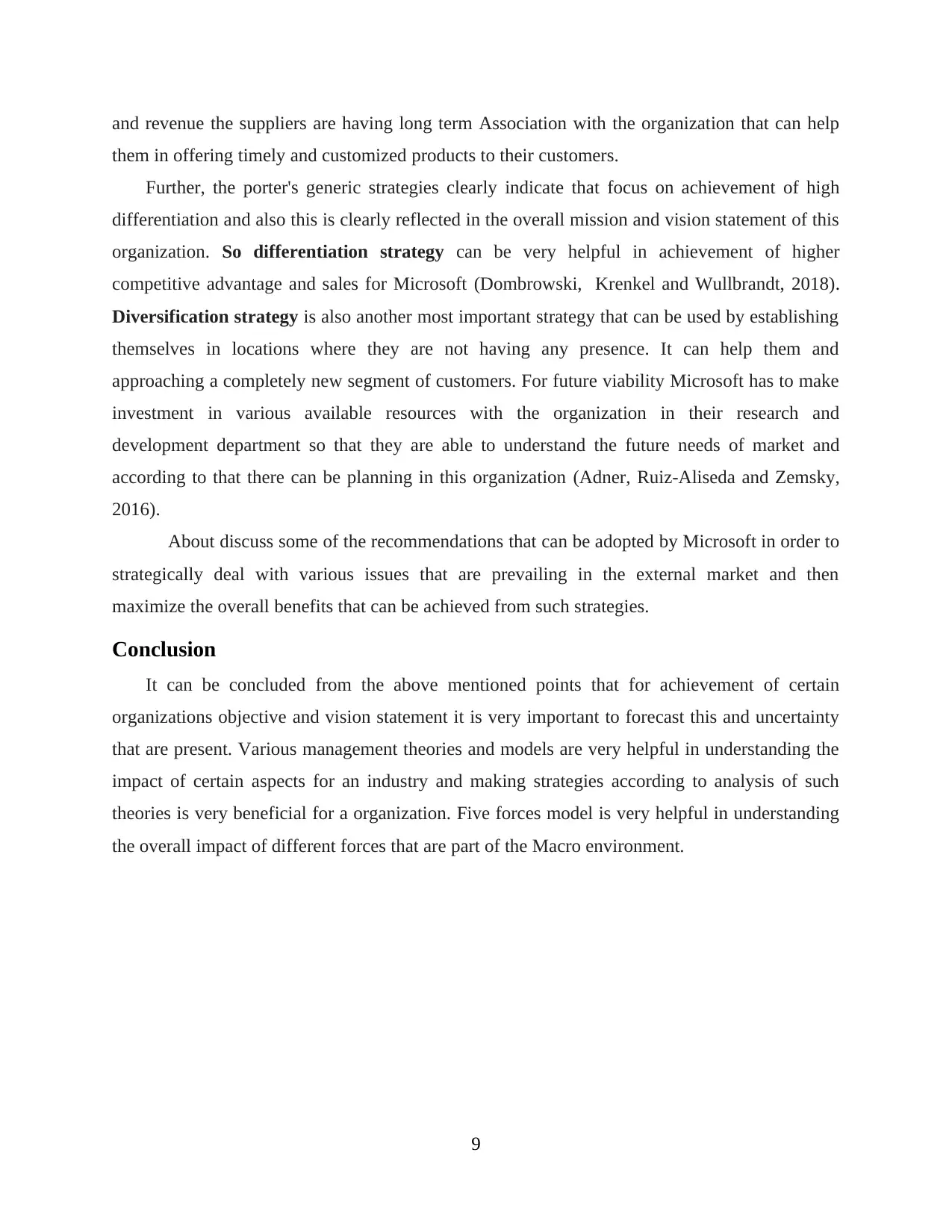
and revenue the suppliers are having long term Association with the organization that can help
them in offering timely and customized products to their customers.
Further, the porter's generic strategies clearly indicate that focus on achievement of high
differentiation and also this is clearly reflected in the overall mission and vision statement of this
organization. So differentiation strategy can be very helpful in achievement of higher
competitive advantage and sales for Microsoft (Dombrowski, Krenkel and Wullbrandt, 2018).
Diversification strategy is also another most important strategy that can be used by establishing
themselves in locations where they are not having any presence. It can help them and
approaching a completely new segment of customers. For future viability Microsoft has to make
investment in various available resources with the organization in their research and
development department so that they are able to understand the future needs of market and
according to that there can be planning in this organization (Adner, Ruiz-Aliseda and Zemsky,
2016).
About discuss some of the recommendations that can be adopted by Microsoft in order to
strategically deal with various issues that are prevailing in the external market and then
maximize the overall benefits that can be achieved from such strategies.
Conclusion
It can be concluded from the above mentioned points that for achievement of certain
organizations objective and vision statement it is very important to forecast this and uncertainty
that are present. Various management theories and models are very helpful in understanding the
impact of certain aspects for an industry and making strategies according to analysis of such
theories is very beneficial for a organization. Five forces model is very helpful in understanding
the overall impact of different forces that are part of the Macro environment.
9
them in offering timely and customized products to their customers.
Further, the porter's generic strategies clearly indicate that focus on achievement of high
differentiation and also this is clearly reflected in the overall mission and vision statement of this
organization. So differentiation strategy can be very helpful in achievement of higher
competitive advantage and sales for Microsoft (Dombrowski, Krenkel and Wullbrandt, 2018).
Diversification strategy is also another most important strategy that can be used by establishing
themselves in locations where they are not having any presence. It can help them and
approaching a completely new segment of customers. For future viability Microsoft has to make
investment in various available resources with the organization in their research and
development department so that they are able to understand the future needs of market and
according to that there can be planning in this organization (Adner, Ruiz-Aliseda and Zemsky,
2016).
About discuss some of the recommendations that can be adopted by Microsoft in order to
strategically deal with various issues that are prevailing in the external market and then
maximize the overall benefits that can be achieved from such strategies.
Conclusion
It can be concluded from the above mentioned points that for achievement of certain
organizations objective and vision statement it is very important to forecast this and uncertainty
that are present. Various management theories and models are very helpful in understanding the
impact of certain aspects for an industry and making strategies according to analysis of such
theories is very beneficial for a organization. Five forces model is very helpful in understanding
the overall impact of different forces that are part of the Macro environment.
9
⊘ This is a preview!⊘
Do you want full access?
Subscribe today to unlock all pages.

Trusted by 1+ million students worldwide
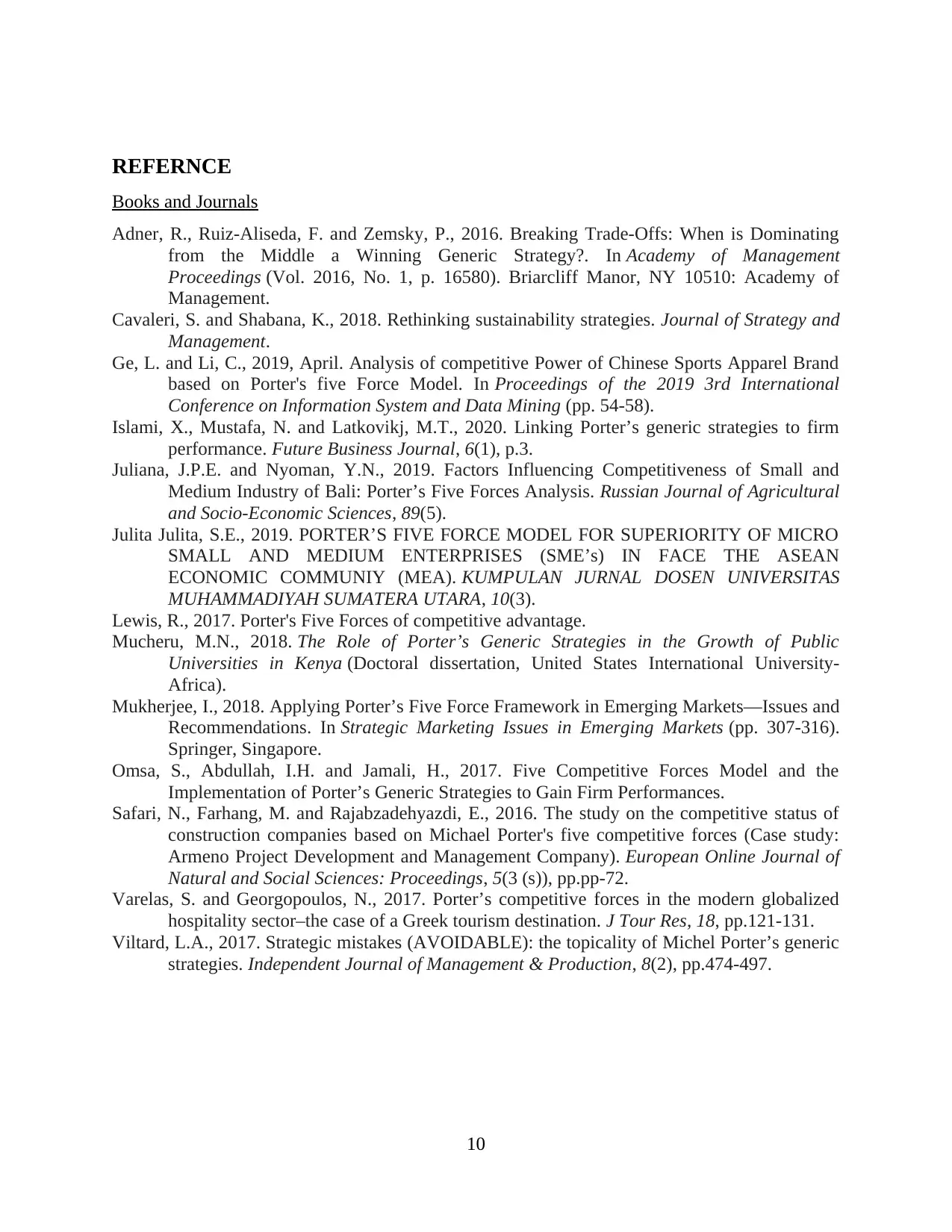
REFERNCE
Books and Journals
Adner, R., Ruiz-Aliseda, F. and Zemsky, P., 2016. Breaking Trade-Offs: When is Dominating
from the Middle a Winning Generic Strategy?. In Academy of Management
Proceedings (Vol. 2016, No. 1, p. 16580). Briarcliff Manor, NY 10510: Academy of
Management.
Cavaleri, S. and Shabana, K., 2018. Rethinking sustainability strategies. Journal of Strategy and
Management.
Ge, L. and Li, C., 2019, April. Analysis of competitive Power of Chinese Sports Apparel Brand
based on Porter's five Force Model. In Proceedings of the 2019 3rd International
Conference on Information System and Data Mining (pp. 54-58).
Islami, X., Mustafa, N. and Latkovikj, M.T., 2020. Linking Porter’s generic strategies to firm
performance. Future Business Journal, 6(1), p.3.
Juliana, J.P.E. and Nyoman, Y.N., 2019. Factors Influencing Competitiveness of Small and
Medium Industry of Bali: Porter’s Five Forces Analysis. Russian Journal of Agricultural
and Socio-Economic Sciences, 89(5).
Julita Julita, S.E., 2019. PORTER’S FIVE FORCE MODEL FOR SUPERIORITY OF MICRO
SMALL AND MEDIUM ENTERPRISES (SME’s) IN FACE THE ASEAN
ECONOMIC COMMUNIY (MEA). KUMPULAN JURNAL DOSEN UNIVERSITAS
MUHAMMADIYAH SUMATERA UTARA, 10(3).
Lewis, R., 2017. Porter's Five Forces of competitive advantage.
Mucheru, M.N., 2018. The Role of Porter’s Generic Strategies in the Growth of Public
Universities in Kenya (Doctoral dissertation, United States International University-
Africa).
Mukherjee, I., 2018. Applying Porter’s Five Force Framework in Emerging Markets—Issues and
Recommendations. In Strategic Marketing Issues in Emerging Markets (pp. 307-316).
Springer, Singapore.
Omsa, S., Abdullah, I.H. and Jamali, H., 2017. Five Competitive Forces Model and the
Implementation of Porter’s Generic Strategies to Gain Firm Performances.
Safari, N., Farhang, M. and Rajabzadehyazdi, E., 2016. The study on the competitive status of
construction companies based on Michael Porter's five competitive forces (Case study:
Armeno Project Development and Management Company). European Online Journal of
Natural and Social Sciences: Proceedings, 5(3 (s)), pp.pp-72.
Varelas, S. and Georgopoulos, N., 2017. Porter’s competitive forces in the modern globalized
hospitality sector–the case of a Greek tourism destination. J Tour Res, 18, pp.121-131.
Viltard, L.A., 2017. Strategic mistakes (AVOIDABLE): the topicality of Michel Porter’s generic
strategies. Independent Journal of Management & Production, 8(2), pp.474-497.
10
Books and Journals
Adner, R., Ruiz-Aliseda, F. and Zemsky, P., 2016. Breaking Trade-Offs: When is Dominating
from the Middle a Winning Generic Strategy?. In Academy of Management
Proceedings (Vol. 2016, No. 1, p. 16580). Briarcliff Manor, NY 10510: Academy of
Management.
Cavaleri, S. and Shabana, K., 2018. Rethinking sustainability strategies. Journal of Strategy and
Management.
Ge, L. and Li, C., 2019, April. Analysis of competitive Power of Chinese Sports Apparel Brand
based on Porter's five Force Model. In Proceedings of the 2019 3rd International
Conference on Information System and Data Mining (pp. 54-58).
Islami, X., Mustafa, N. and Latkovikj, M.T., 2020. Linking Porter’s generic strategies to firm
performance. Future Business Journal, 6(1), p.3.
Juliana, J.P.E. and Nyoman, Y.N., 2019. Factors Influencing Competitiveness of Small and
Medium Industry of Bali: Porter’s Five Forces Analysis. Russian Journal of Agricultural
and Socio-Economic Sciences, 89(5).
Julita Julita, S.E., 2019. PORTER’S FIVE FORCE MODEL FOR SUPERIORITY OF MICRO
SMALL AND MEDIUM ENTERPRISES (SME’s) IN FACE THE ASEAN
ECONOMIC COMMUNIY (MEA). KUMPULAN JURNAL DOSEN UNIVERSITAS
MUHAMMADIYAH SUMATERA UTARA, 10(3).
Lewis, R., 2017. Porter's Five Forces of competitive advantage.
Mucheru, M.N., 2018. The Role of Porter’s Generic Strategies in the Growth of Public
Universities in Kenya (Doctoral dissertation, United States International University-
Africa).
Mukherjee, I., 2018. Applying Porter’s Five Force Framework in Emerging Markets—Issues and
Recommendations. In Strategic Marketing Issues in Emerging Markets (pp. 307-316).
Springer, Singapore.
Omsa, S., Abdullah, I.H. and Jamali, H., 2017. Five Competitive Forces Model and the
Implementation of Porter’s Generic Strategies to Gain Firm Performances.
Safari, N., Farhang, M. and Rajabzadehyazdi, E., 2016. The study on the competitive status of
construction companies based on Michael Porter's five competitive forces (Case study:
Armeno Project Development and Management Company). European Online Journal of
Natural and Social Sciences: Proceedings, 5(3 (s)), pp.pp-72.
Varelas, S. and Georgopoulos, N., 2017. Porter’s competitive forces in the modern globalized
hospitality sector–the case of a Greek tourism destination. J Tour Res, 18, pp.121-131.
Viltard, L.A., 2017. Strategic mistakes (AVOIDABLE): the topicality of Michel Porter’s generic
strategies. Independent Journal of Management & Production, 8(2), pp.474-497.
10
Paraphrase This Document
Need a fresh take? Get an instant paraphrase of this document with our AI Paraphraser
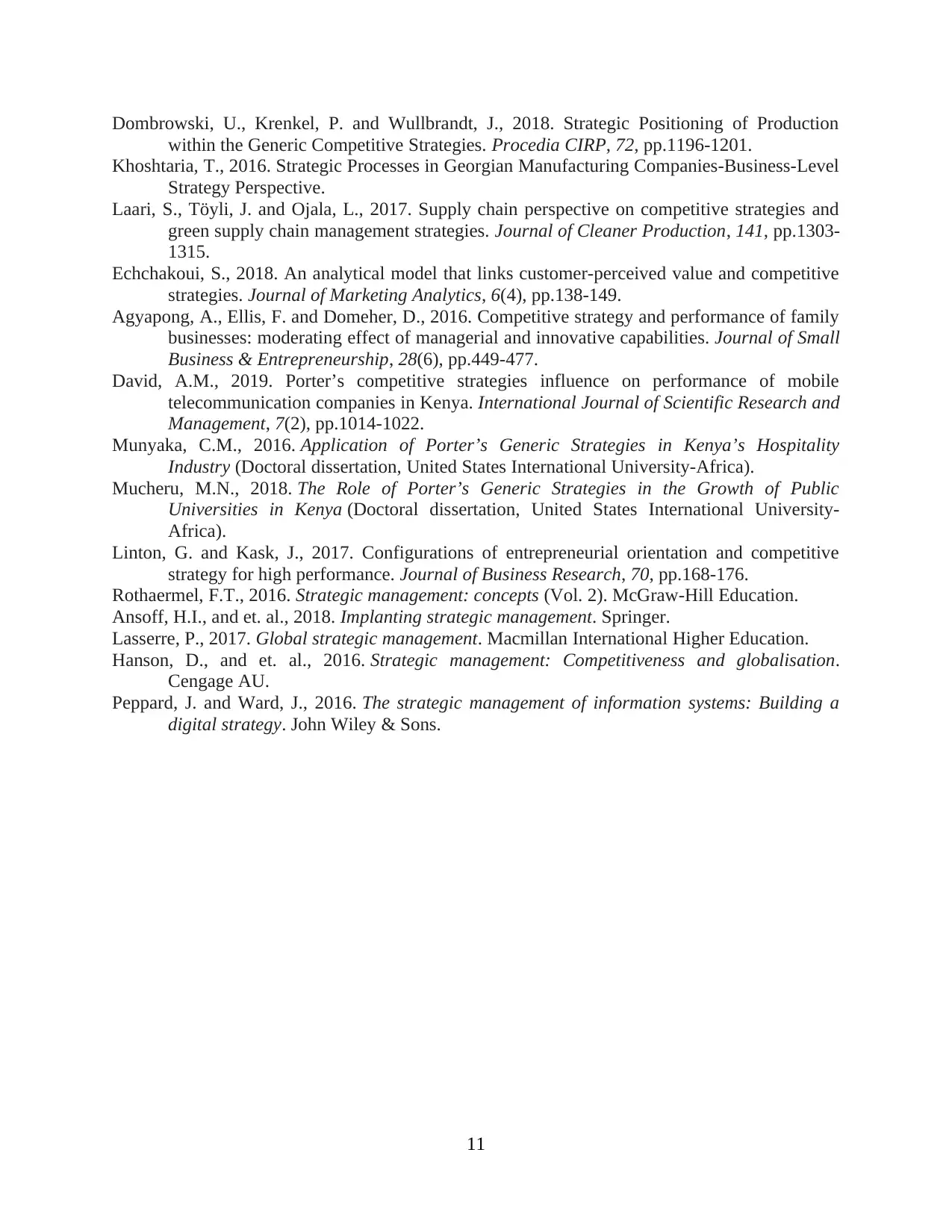
Dombrowski, U., Krenkel, P. and Wullbrandt, J., 2018. Strategic Positioning of Production
within the Generic Competitive Strategies. Procedia CIRP, 72, pp.1196-1201.
Khoshtaria, T., 2016. Strategic Processes in Georgian Manufacturing Companies-Business-Level
Strategy Perspective.
Laari, S., Töyli, J. and Ojala, L., 2017. Supply chain perspective on competitive strategies and
green supply chain management strategies. Journal of Cleaner Production, 141, pp.1303-
1315.
Echchakoui, S., 2018. An analytical model that links customer-perceived value and competitive
strategies. Journal of Marketing Analytics, 6(4), pp.138-149.
Agyapong, A., Ellis, F. and Domeher, D., 2016. Competitive strategy and performance of family
businesses: moderating effect of managerial and innovative capabilities. Journal of Small
Business & Entrepreneurship, 28(6), pp.449-477.
David, A.M., 2019. Porter’s competitive strategies influence on performance of mobile
telecommunication companies in Kenya. International Journal of Scientific Research and
Management, 7(2), pp.1014-1022.
Munyaka, C.M., 2016. Application of Porter’s Generic Strategies in Kenya’s Hospitality
Industry (Doctoral dissertation, United States International University-Africa).
Mucheru, M.N., 2018. The Role of Porter’s Generic Strategies in the Growth of Public
Universities in Kenya (Doctoral dissertation, United States International University-
Africa).
Linton, G. and Kask, J., 2017. Configurations of entrepreneurial orientation and competitive
strategy for high performance. Journal of Business Research, 70, pp.168-176.
Rothaermel, F.T., 2016. Strategic management: concepts (Vol. 2). McGraw-Hill Education.
Ansoff, H.I., and et. al., 2018. Implanting strategic management. Springer.
Lasserre, P., 2017. Global strategic management. Macmillan International Higher Education.
Hanson, D., and et. al., 2016. Strategic management: Competitiveness and globalisation.
Cengage AU.
Peppard, J. and Ward, J., 2016. The strategic management of information systems: Building a
digital strategy. John Wiley & Sons.
11
within the Generic Competitive Strategies. Procedia CIRP, 72, pp.1196-1201.
Khoshtaria, T., 2016. Strategic Processes in Georgian Manufacturing Companies-Business-Level
Strategy Perspective.
Laari, S., Töyli, J. and Ojala, L., 2017. Supply chain perspective on competitive strategies and
green supply chain management strategies. Journal of Cleaner Production, 141, pp.1303-
1315.
Echchakoui, S., 2018. An analytical model that links customer-perceived value and competitive
strategies. Journal of Marketing Analytics, 6(4), pp.138-149.
Agyapong, A., Ellis, F. and Domeher, D., 2016. Competitive strategy and performance of family
businesses: moderating effect of managerial and innovative capabilities. Journal of Small
Business & Entrepreneurship, 28(6), pp.449-477.
David, A.M., 2019. Porter’s competitive strategies influence on performance of mobile
telecommunication companies in Kenya. International Journal of Scientific Research and
Management, 7(2), pp.1014-1022.
Munyaka, C.M., 2016. Application of Porter’s Generic Strategies in Kenya’s Hospitality
Industry (Doctoral dissertation, United States International University-Africa).
Mucheru, M.N., 2018. The Role of Porter’s Generic Strategies in the Growth of Public
Universities in Kenya (Doctoral dissertation, United States International University-
Africa).
Linton, G. and Kask, J., 2017. Configurations of entrepreneurial orientation and competitive
strategy for high performance. Journal of Business Research, 70, pp.168-176.
Rothaermel, F.T., 2016. Strategic management: concepts (Vol. 2). McGraw-Hill Education.
Ansoff, H.I., and et. al., 2018. Implanting strategic management. Springer.
Lasserre, P., 2017. Global strategic management. Macmillan International Higher Education.
Hanson, D., and et. al., 2016. Strategic management: Competitiveness and globalisation.
Cengage AU.
Peppard, J. and Ward, J., 2016. The strategic management of information systems: Building a
digital strategy. John Wiley & Sons.
11
1 out of 11
Related Documents
Your All-in-One AI-Powered Toolkit for Academic Success.
+13062052269
info@desklib.com
Available 24*7 on WhatsApp / Email
![[object Object]](/_next/static/media/star-bottom.7253800d.svg)
Unlock your academic potential
Copyright © 2020–2025 A2Z Services. All Rights Reserved. Developed and managed by ZUCOL.





